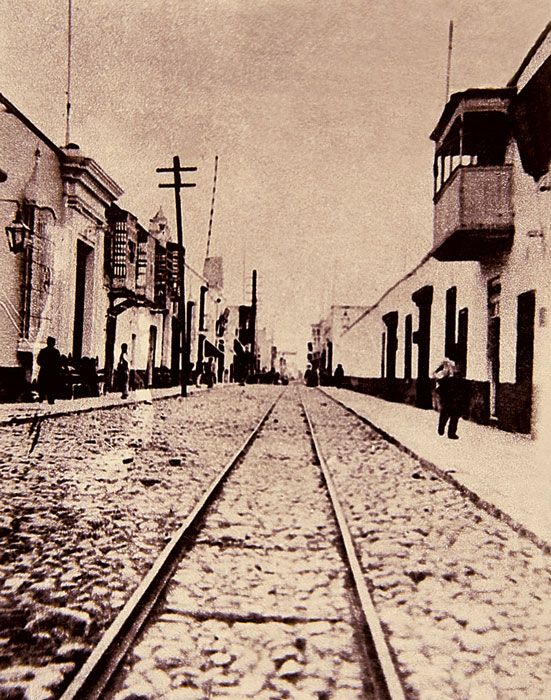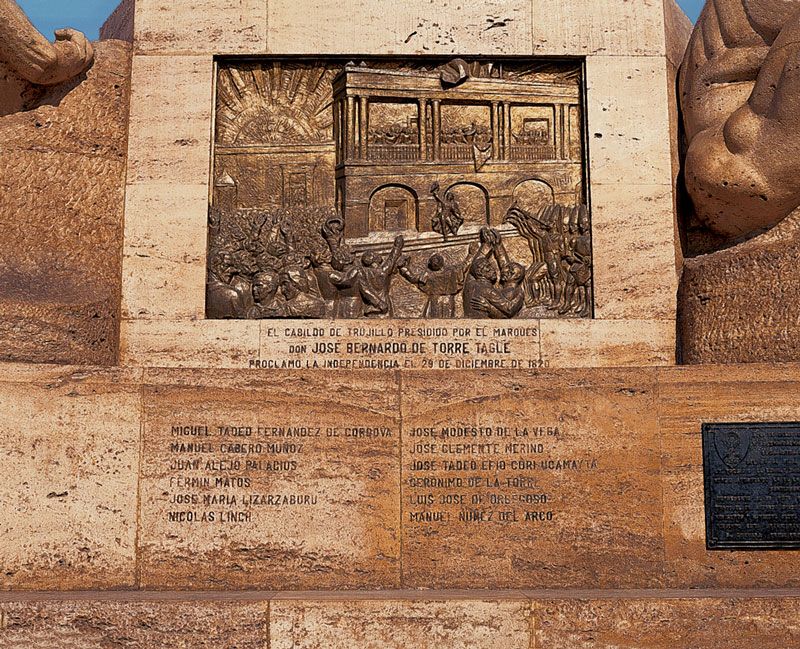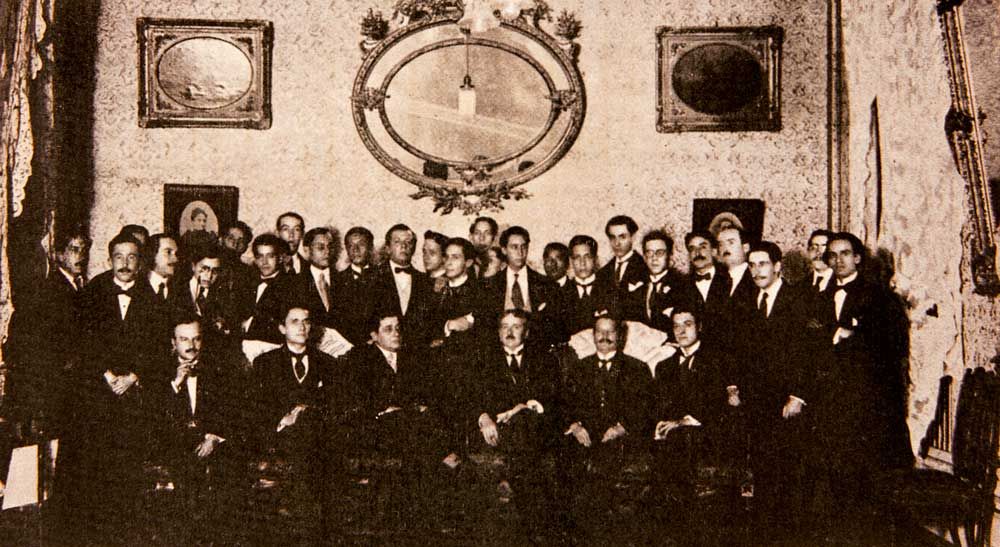
Sixth block of Francisco Pizarro in Trujillo. The tracks of the old railroad are visible.
Macedonio´s made his return to Peru in 1917 through Northern Argentina and Bolivia. He entered the country at the port of Arica, where he made his first individual exhibition of works he had painted in Buenos Aires. The young painter returned to his native country enriched by his initial international experiences, which had pushed him to explore other horizons and eventually decide for a permanent profession in painting. From this point on, painting would become his all-encompassing and predominant inclination, although he would later be attracted by sculpture, whose basic principles he had learned in Buenos Aires at Orlando Stagnaro´s atelier.
Now in his country, Macedonio met up again with friends and classmates that had advanced their studies at the University of Trujillo. In 1917, César Vallejo was in his third year of law, as were Oscar Imaña, Federico Esquerre, Ruperto Pimentel, Manuel Cevallos and others. The most notable amongst the group was the poet Santiago de Chuco, who had consistently been a top student at the School of Philosophy and the Arts since his admittance in 1913. Despite the fact the Macedonio found all his friends on the way to finishing their degrees, very few of these individuals became lawyers; instead, most made a definitive turn towards literature and journalism.
Outside of the university cloisters, an intense cultural panorama was played out in the hearts of the select group of young men that met regularly in the home of a poet from Piura- native of Huancabamba- Jose Eulogio Garrido. This great entertainer lived in a spacious room on the second floor of a home belonging to his relatives, the Espinoza family, on the fifth block of Indepedencia Street- formerly La Catedral- next to the city’s largest church.

Sixth block of Francisco Pizarro in Trujillo. The tracks of the old railroad are visible.
Plaque at the Monument to Liberty in the Plaza Mayor of Trujillo. Gerónimo de la Torre´s name is inscribed here.

This circle was described in an article titled “ The Bohemians of Trujillo, written by poet Juan Parra del Riego for the October, 1916 issue of the magazine Balnearios de Barranco. These so-called “bohemians” would later be known as the “Grupo Norte” (after the paper El Norte that Antenor Orrego would direct later in 1923), was made up of César Vallejo, who was a student lodger in the Hotel del Arco located on a street of the same name, and Antenor Orrego, Macedonio de la Torre, Alcides Spelucín, Federico Esquerre – who signed as Essquerriloff–, Oscar Imaña, Víctor Raúl Haya de la Torre, Agustín Haya de la Torre and later Francisco Xandóval, Eloy Daniel Espinoza, Juan Espejo Asturrizaga, Camilo Blas and Carlos Manuel Porras.
These unique young men, anxious to learn about the arts and literature, constituted an admirable circle that endeavored to overcome the retiring nature of old city- silent, placid and traditional. Trujillo, with its scarce cultural life, shadowy streets and insufficient public lighting, was home to several newspapers, the Industria, founded in 1895, and La Reforma, La Razón and El Federal, all of which reported almost exclusively on Lima based on news received by telegraph. Everything felt stagnant during the monotonous nights of this city of seventeen thousand inhabitants, with the exception of events taking place on the grounds of a home located but a few steps from the Main Plaza.

Reception held by Macedonio de la Torre in the family house on Jirón Gamarra in Trujillo on June 17, 1917. Present amongst others are César Vallejo, José Eulogio Garrido, Antenor Orrego, Alcides Spelucín, Carlos Valderrama, Federico Esquerre, José Félix de la Puente, Oscar Imaña, Eloy Espinoza, Agustín Haya de la Torre, Ignacio Meave Seminario and Gustavo Romero Lozada y Laínez, Macedonio’s future father in law. The painter is standing in the center.
These intellectual encounters lasted from 1914-1917, at which point the group began to disperse. During these meetings, Jose Eulogio (who possessed a beautiful voice) recited in French, taking advantage of the Lazarist education he had received. Here, for the first time, the words of the premier authors of modernism were eagerly heard, and particular attention was paid to the writings of the Nicaraguan poet Rubén Darío, the Spanish masters of the generation of 98, the Uruguayan poet Julio Herrera y Reissig – who greatly influenced Vallejo´s early works-, the Mexican Amado Nervo, French nationals Charles Baudelaire, Paul Verlaine and Jules Laforgue, the great North American poets Walt Whitman y R. W. Emerson, the Belgian Maurice Maeterlinck, the Uruguayan essayist José Enrique Rodó, our brilliant and sweet storyteller from Pisco, Abraham Valdelomar, and the unique and elegant poet from Lima, José María Eguren. It was during this period that the young men of this bohemian group received sporadic visits from intellectuals from the capital- the poet Juan Parra del Riego and Dr. Javier Prado Ugarteche in 1916; the ethnomusicologist and composer Daniel Alomía Robles, the poet Enrique Bustamante y Ballivián; the dancer Norka Rouskaya in 1917 and the author Abraham Valdelomar- who brought life to the peaceful and languid city atmosphere with his presence- in 1918.
Garrido, who was slight in stature and had a limp, possessed a strong character and a clear voice. He generously received these young students from this illustrious bohemian group, and enriched the knowledge of the circle’s members by bringing new books from abroad that he had access to through his position as head writer at the newspaper La Industria. It would be a mistake to think, however, that Garrido was the only member of the circle with an inquiring mind. In fact, there were many opportunities to engage in other activities, such as that initiated by Macedonio de la Torre a few weeks after his attendance at the meetings began. José Eulogio Garrido had convened his companions in his room for a séance. At the beginning of the session, he called upon the spirits utilizing a three-legged table free of nails and other metal objects. In the middle of the séance, Macedonio began to play a very sad melody on his violin, filling the air with frightening melancholy. Those present at the session held on to one another, shaken by this music that seemed to announce the imminent apparition of souls from another world. But they were wrong! Our artist, who had no faith whatsoever in the invocatory powers of José Eulogio, was actually playing his violin to express his disconsolation because the girl who lived in the house across the street, Miss Anita Larrea, had recently rejected his most ardent declarations of love!